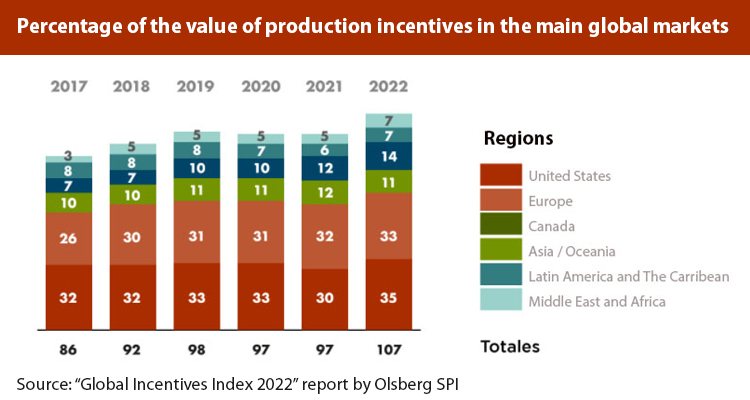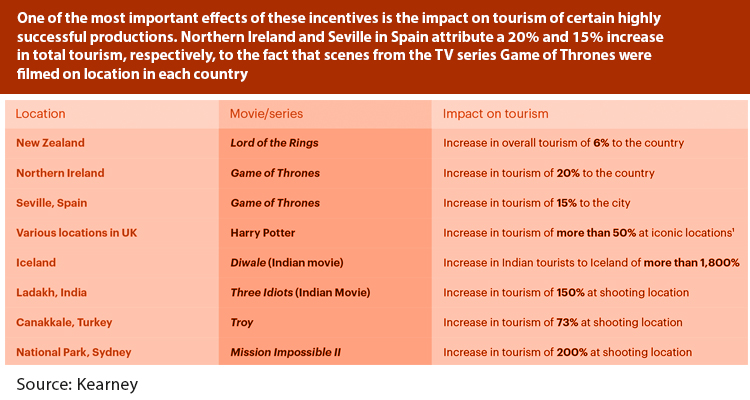Audiovisual co-productions and the incentives to carry them out continue to play a valuable role in the global content industry. With a general rate of around 25-30% of eligible spending (although higher rates and other benefits are offered), they can provide developers with the cornerstone of a financing plan for their project and an instrumental role in locating funds. the productions.
The reason for the importance of these continues to grow, due to the additional costs related to the pandemic that seek to guarantee security during filming.
By December 2021, more than 100 incentive programs for film and television production were being implemented in more than 40 countries.

Emerging markets such as MEA and Latin America have so far attracted significant foreign investment. In 2020, according to the Kearney consultancy, MEA attracted approximately US$3 million and LATAM US$6 million. Recent incentive programs launched by the Kingdom of Saudi Arabia and Morocco have helped increase investment, and there is great potential for this region to attract a higher share of global production spending.
In this report, Prensario reviews the new markets that have joined this trend, as well as those that have made changes to their existing programs.
Austria is one of the countries that recently announced a renewed incentive program. Film in Austria has welcomed the Austrian government’s decision to introduce a 35% incentive for film and television production. The measure entered into force on January 1 and is in the form of an automatically non-refundable subsidy. The contributions will be up to 5 million euros for film projects and 7.5 million euros for serial projects. In detail, the incentive consists of a 30% cash bonus for each project, and an additional 5% ecological bonus, based on the implementation of certain environmental sustainability criteria.
Thailand also approved a large increase in audiovisual incentives in the country. Under the scheme approved in 2018, which established that foreign productions can obtain a 15% discount on their localization activities in the country, with an additional 5% for those shoots that use a significant proportion of local personnel, promote culture and Thai cinema in second-tier or lesser-known places. The maximum refund is limited to THB75 million ($2.25 million) per film.
The new program offers a base level of rebate that is increased to 20% while the rebate is doubled to 10%, making a potential total subsidy of 30% of production spend in Thailand. The maximum refund allowed is also THB150 million ($4.50 million).
For its part, the Finnish government recently made changes to the minimum requirements for the production incentive granted by the “Business Finland” program for this year. The most significant change is related to the amount of funding from outside Finland, which will be at least 25%. Likewise, the general budget approved last year, of 9.5 million authorized and the additional financing of 7.5 million euros received in June are linked, it will be complemented with an additional 3 million euros until the end of this year.

In Serbia, the incentive policy for this year was renewed, which this time includes a new regulation, which came into force last January. In this sense, the government seeks to attract audiovisual investment with a cash rebate that goes from 25% of qualified Serbian spending for feature films, TV series, documentaries, animation and post-production work, to 20% for TV commercials, and 30% for feature films with Serbian expenditure of at least 5 million euros.
Meanwhile, Sweden is already seeing the first cycle of its incentive program materialize with a new and increasing budget that came into force last year, and whose call closed two days later, due to great demand. The scheme administered by the Suena Agency for Economic Growth has an annual budget of 9.2 million euros, and stipulates a 25% cash rebate for projects with costs carried out locally above 368 thousand euros for a film.
The program has financed more than 1,300 productions since its inception in 30 years, including the award-winning titles Triangle of Sadness, Holy Spider, Boy from Heaven. It also offers a wide range of post-production and filming facilities such as Studio Fares Trollhättan, the second largest sound stage in Scandinavia and its new virtual production wall (24×8 meters), which was launched on January 31st.







